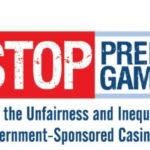A growing number of America’s young people are in danger of gambling away their futures—literally.
Studies point to a dangerous trend toward problem gambling among 14- to 21-year-olds who face a dizzying array of enticing gambling options, all with big potential payoffs.
|
One study estimates 2.9 million young people are gambling on cards on a weekly basis.
|
Experts are alarmed about early-age gambling because they believe adolescents are more likely than adults to become problem gamblers—as much as three times more likely. And recent research confirms some youngsters increasingly are introduced to gambling as early teens or younger through peers, state lotteries, the Internet and their own families.
One study estimates 2.9 million young people are gambling on cards on a weekly basis.
One of the most comprehensive surveys of gambling among American young people is “The Prevalence of Problem Gambling Among U.S. Adolescents and Young Adults: Results From a National Survey”—released in late 2007. Researchers interviewed 2,274 randomly selected U.S. residents ages 14 to 21.
Among the key findings from the survey—one of the few not limited to a regional sampling—were:
• 68 percent of the young people who responded said they had gambled in the past year.
• 11 percent acknowledged gambling at least twice a week.
• 6.5 percent were considered at-risk or problem gamblers, and 2.1 percent were clearly problem gamblers.
Sign up for our weekly edition and get all our headlines in your inbox on Thursdays
• Males ranked significantly higher than females in every measure of gambling involvement. Other studies suggest females tend to become more actively involved in gambling as adults.
• Young people who have more access to money tend to have more gambling involvement.
• Non-students—particularly those with regular income—were more likely to have gambled than students.
• Young people living independently were significantly more likely to have gambled in the past year than those living with parents.
• Researchers estimate three-quarters of a million problem gamblers ages 14-21 in the United States.
Various studies suggest a strong correlation between problem gambling and substance and alcohol abuse.
Alarming as they are, these latest findings suggest rates of problem gambling somewhat lower than some previous studies, some of which were considerably more regional in scope.
The games of choice for young gamblers identified in one survey might surprise parents.
A 2006 study of four Minnesota colleges suggested the top three most commonly played games among the surveyed students were slot machines at 70 percent, the lottery at 63 percent and Texas Hold ’Em poker at 46 percent.
Among the games played on a weekly basis, Texas Hold ’Em—by far the most popular form of poker—wins the jackpot, hands down. Four percent of the surveyed students report playing Texas Hold ’Em for money with friends weekly, and an almost equal number play the game online for money every week.
“Texas Hold ’Em online for money is the most popular game being played by probable pathological gamblers on a weekly basis,” the Minnesota researchers concluded in an executive summary of their findings.
Among other demographic factors, the 2007 study looked at religious preferences and the relative prevalence of gambling among young people in each.
Muslims, Hindus, Buddhists, Jehovah’s Witnesses and others had low rates of having gambled in the previous year. But if they gambled, they had higher rates of frequent gambling than any other religious group.
Similarly, researchers found Baptists were less likely than other Protestants to have gambled in the past year. However, when Baptist young people gambled, they exhibited higher rates of frequent gambling, according to the study.
The modern-day legalization of various forms of gambling, its effective promotion and the availability of gambling on the Internet have made the enterprise readily available to and a potential temptation to virtually anyone, including teens and young adults. And the results can be disastrous.
“Gambling addiction is destructive when limited to Las Vegas, Louisiana and state lotteries. Put it right in people’s homes, and its destructive power is devastating,” said Weston Ware of Texans Against Gambling.
“Internet gambling has all of the most addictive elements of all forms of gambling, plus an added measure of anonymity. It makes nearly every dorm room, home and office in America a potential casino and turns every computer into a virtual addiction-delivery device. We just don’t need gambling in our homes and offices—much less our universities.”
Les Bernal, executive director of Stop Predatory Gambling, a national citizens movement, pointed to a 2006 report that provides a demographic breakdown of people who play the Texas Lottery. It showed young people ages 18 to 24 spend a median $50 a month playing the state lottery.
“Predatory gambling touches all age groups and demographics, but it hits the youngest the hardest,” Bernal concluded.
Internet gambling presents a special challenge because of the difficulty in controlling access, he noted. And the gambling industry sees college-age young adults as a market to be tapped.
“The industry recognizes the profit potential of that demographic,” Bernal said.
College-age students who become ensnared by the lure of the Texas Hold ’Em fad should realize the poker tournaments are not just benign fun and games, Ware added.
“Texas Hold ’Em is not just marbles and pitching pennies,” he said.
“Don’t think that these games are the innocent results of kids wanting to play cards for a diversion. Texas Hold ’Em tournaments and events with various designations are businesses designed to make money. And ultimately most of the money will be made from those who fall victim to gambling as addiction rather than entertainment.”













We seek to connect God’s story and God’s people around the world. To learn more about God’s story, click here.
Send comments and feedback to Eric Black, our editor. For comments to be published, please specify “letter to the editor.” Maximum length for publication is 300 words.